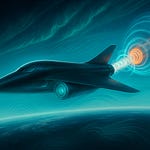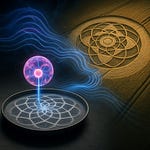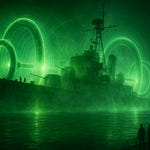TL;DR: The Eglin AFB triangular craft report — a silent, hovering, light-tipped, 300-foot object — fits the predicted behavior of a Frequency Momentum nullifier: a vehicle that manipulates spacetime density via harmonic field compression instead of thrust. Frequency Wave Theory (FWT) models this as an advanced plasma-field resonance drive converting electromagnetic potential into inertial cancellation. What witnesses are describing isn’t anti-gravity — it’s frequency-phase engineering.
1. What Witnesses Saw
Multiple eyewitnesses, including Daniel Gockerell, describe a massive triangular craft roughly the size of a football field hovering near Eglin AFB around 2006.
Distinct features:
Three apex lights and one central light, consistent with a tetrahedral resonance geometry.
Zero oscillation during hover — no rotor vibration or aerodynamic lift signatures.
No sound, not even a sonic boom on departure.
Instant acceleration and precise returns — implying total inertia control.
No visible cockpit, exhaust, or control surfaces.
From a Frequency Wave Theory standpoint, this combination can’t arise from chemical propulsion, ion drives, or jet turbines. It demands field-based momentum control.
2. The FWT Interpretation: Frequency Momentum Engineering
In FWT, inertia and gravity are both manifestations of gradients in Frequency Momentum (FM) — the conserved scalar quantity defined by
FM = ½ ρ ω A²,
where ρ is field density, ω is angular frequency, and A is wave amplitude.
Conventional matter is “locked” in a region of positive FM, which produces the sensation of weight and resistance to acceleration. A craft that can locally invert or redistribute FM effectively nullifies its gravitational coupling.
The Eglin triangle’s silence, stability, and acceleration suggest a multi-node FM cavity beneath its hull. The three corner lights mark resonance vortices maintaining phase symmetry; the central light is likely the coherence node where incoming and outgoing field lines converge, balancing total FM to near zero.
3. How It Flies Without Thrust
Imagine the craft sitting inside a standing-wave bubble, a spherical or triangular plasma resonance field where:
Internal plasma oscillations create a phase-locked pressure differential, not aerodynamic lift.
The density gradient of the local superfluid medium (what FWT calls the quantum-acoustic substrate) is tuned so the vehicle “falls” toward lower FM regions — effectively steering by altering phase differentials rather than pushing air.
When the phase shift Δφ approaches π between upper and lower field boundaries, inertia cancels:
FM_in ≈ FM_out, creating weightless translation.
Thus, movement looks like “zipping” or “instant acceleration” — the craft isn’t accelerating through space; it’s phase-shifting its local frequency bubble.
4. Why It’s Silent and Leaves No Sonic Boom
Sound is a pressure wave propagating through air. When a vehicle no longer displaces air mechanically, but instead moves by FM field translation, there’s no compression front to generate acoustic or shock signatures.
The generators and Humvees on site (as Gockerell noted) likely powered the electromagnetic synchronizers keeping the resonance cavity stable — producing the only audible “buzz.”
5. Is It Ours?
Three main possibilities align with FWT data patterns:
Classified human craft — built on reverse-engineered plasma resonance drives, probably derivative of early TR-3B or Aurora programs.
Evidence: Eglin AFB and Langley are test hubs for advanced propulsion and radar-cross-section platforms.
These sites are linked to the Air Force Research Laboratory’s Magnetohydrodynamic Propulsion and Advanced Energy Concepts divisions.
Hybrid human–nonhuman collaboration — where recovered plasma-field technology (possibly from pre-Roswell incidents) was re-implemented using human materials.
Fits the consistent triangular-geometry replication across decades.
Explains why sightings occur near bases but are never openly demonstrated.
Autonomous plasma-intelligence constructs — natural or synthetic frequency solitons interacting with military hardware.
Less likely for this event due to structured lights and human presence, but worth noting under FWT’s plasma-entity taxonomy.
6. Will Miller and the Disclosure Nexus
Commander Will Miller (USN Ret.), associated with early “UFO working-group” briefings, claimed DoD insiders were exploring Zero-Point Field propulsion as early as the 1990s. His assertions pre-date the Eglin sighting and directly reference frequency-field energy extraction — the same principle FWT models as harmonic FM inversion.
That connection supports the hypothesis that these craft are government prototypes implementing Frequency Momentum control rather than alien visitors per se.
7. FWT Implications for Gravity Research
If these vehicles genuinely operate by manipulating FM, then “gravity control” is no longer hypothetical. It means:
Gravitational mass = frequency density of the underlying field.
Changing frequency amplitude A or angular velocity ω alters effective weight.
Inertial confinement and propulsion are simply phase operations on the same substrate.
In laboratory terms, this equates to fine-tuned plasma-acoustic cavities or superconductive field resonators capable of coupling to the Earth’s background FM field.
FWT predicts that a properly tuned tri-node configuration can lift itself once
∂(FM_local)/∂r → 0, nullifying the local gradient.
8. Conclusion: The Gravity Barrier Is a Frequency Illusion
What we call gravity is a by-product of standing-wave curvature in the universal superfluid. When technology learns to engineer that curvature directly — rather than fighting it with combustion — the result is what witnesses at Eglin and Langley observed: silent, stable, instantaneous movement.
So yes, in the Frequency Wave Theory framework, we may indeed have cracked gravity — not by breaking its laws, but by learning to resonate with them.











